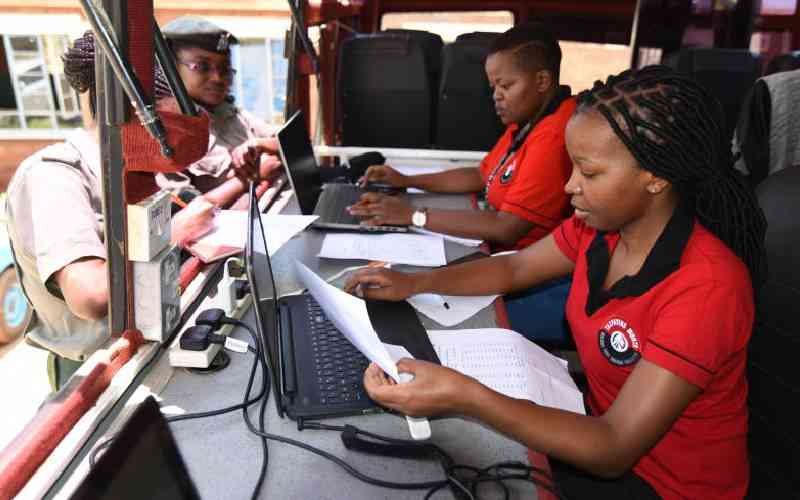
Kenya has achieved its target of universal access to HIV diagnosis, treatment, and viral suppression, marking a significant milestone in the fight against HIV/AIDS.
According to the latest HIV estimates report, by 2023, 97 per cent of the population knew their HIV status, 97 per cent of those diagnosed were on antiretroviral therapy (ART) and 94 per cent of those on treatment achieved viral suppression.
This success surpasses the global UNAIDS 95-95-95 target for epidemic control, which aims for at least 95 per cent of people to know their HIV status, 95 per cent to be on treatment, and 95 per cent to achieve viral suppression.
In 2023, 1,378,457 Kenyans were living with HIV, of whom 1,336,681 were on treatment, a gradual increase from 1.2 million in 2022.
Dr Japheth Kioko, a statistician Monitoring and Evaluation Division at the National Syndemic Disease Control Council (NSDCC), applauded the achievement, saying the country is on the right trajectory in eliminating HIV infections and AIDS deaths.
“As a country, we are celebrating the success in testing and treatment, now at 97 per cent,” said Dr Kioko.
However, treatment interruptions remain a challenge, with 41,028 people on ART discontinuing treatment in 2023.
Dr. Kioko warned that these individuals are at risk of transmitting the virus, emphasizing the need to bring them back into care.
“There is a deficit of 41,000 who are likely to transmit HIV. It becomes our responsibility to ensure they resume treatment,” he said.
While women on ART have reached 100 per cent coverage, men and children lag behind.
Only 91 per cent of men are on ART compared to 100 per cent of women.
The report notes that male adults experienced a higher rate of treatment interruption (4.22 per cent) compared to females (3.8 per cent).
ART initiation among men aged 15 and above improved from 81 per cent in 2020 to 90 per cent in 2023 but remains below the UNAIDS target.
In 2023, 1,360 children (3.23 per cent) aged 0 to 14 years interrupted treatment.
Similarly, young adults aged 20–24 years are another vulnerable group in need of targeted interventions.
“Although the proportion of men aged 15 years and above initiating ART has increased from 81 per cent in 2020 to 90 per cent in 2023, the population group is yet to reach the 95 per cent UNAIDS target,” reads a section of the report.
At least 1,360 children aged zero and 14 years representing 3,23 per cent interrupted treatment, 25,884 female adults interrupted treatment, while 13,731 male adults interrupted treatment.
Last year, the number of men who tested positive stood at 30,377 but only 26,518 were out on treatment, whereas last year, out of 32,722 who turned positive, only 29, 337 were started in ART.
In 2020, at least 47, 529 male aged above 15 years tested HIV positive, but only 38, 703 enrolled on ART.
In 2021, the number of men who tested positive for the virus dropped to 41, 943 with only 35,175 enrolling for treatment.
To address the gap, the NSDCC is engaging men and boys as champions for HIV testing, treatment, and viral suppression programs.
Dr Caroline Kinoti, NSDCC Deputy Director for Health Promotion and Capacity Development, highlighted the unique barriers faced by men:
“Unlike women, who often access testing and services during pregnancy, men lack similar opportunities. We aim to have men take the lead in preventing HIV infections and supporting women and girls in eliminating HIV and ending AIDS,” said Kinoti”
Kinoti noted that having a bigger population have knowledge about their status, put on treatment and suppressing viral load will reduce HIV transmission in the country.
“We want people to know their HIV status, and those who test positive to be kept on ART, and we ensure they are virally suppressed then we can ensure that they do not transmit HIV. It is the business of the government to ensure that we reduce, and scale down all deaths which are related to HIV,” emphasised Kioko.
According to documentation by the Ministry of Health, the first case of HIV in Kenya was diagnosed in 1984.
Kenya, which diagnosed its first HIV case in 1984, is home to Africa’s second-largest treatment cohort after South Africa.
With a robust treatment program that includes ART, prevention supplies like condoms, and services for opportunistic infections, the country aims to end AIDS by 2030.
National prevalence of HIV stands at 3.3 per cent with Counties of Kisumu, Homa Bay, Migori, Siaya, Nairobi, Nakuru, Mombasa, Kiambu, Kakamega and Kisii leading in number of people living with the virus.
 The Standard Group Plc is a multi-media organization with investments in media
platforms spanning newspaper print operations, television, radio broadcasting,
digital and online services. The Standard Group is recognized as a leading
multi-media house in Kenya with a key influence in matters of national and
international interest.
The Standard Group Plc is a multi-media organization with investments in media
platforms spanning newspaper print operations, television, radio broadcasting,
digital and online services. The Standard Group is recognized as a leading
multi-media house in Kenya with a key influence in matters of national and
international interest.
 The Standard Group Plc is a multi-media organization with investments in media
platforms spanning newspaper print operations, television, radio broadcasting,
digital and online services. The Standard Group is recognized as a leading
multi-media house in Kenya with a key influence in matters of national and
international interest.
The Standard Group Plc is a multi-media organization with investments in media
platforms spanning newspaper print operations, television, radio broadcasting,
digital and online services. The Standard Group is recognized as a leading
multi-media house in Kenya with a key influence in matters of national and
international interest.











